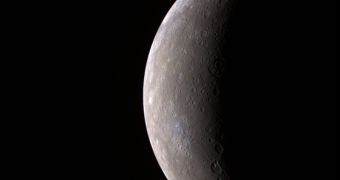How many of us have actually seen Mercury the way it really looks like? Most of the images available are black and white pictures. I don't really understand why this is, color photography wasn't invented yesterday, but I'm pretty sure there is a good reason for this. Last week, NASA's MESSENGER spacecraft made its first flyby around Mercury, during which time it has taken more than 1,200 pictures of the surface of the planet and conducted a series of measurements.
NASA quickly released the newly collected information to the public and, not surprisingly, we received once again more black and white pictures. However, yesterday NASA published MESSENGER's first colored picture of Mercury. The human eye is sensible to electromagnetic radiation in the wavelength between 400 to 700 nanometers, the so-called visible spectrum. On the other hand, MESSENGER's Wide Angle Camera is equipped with about 11 color filters, capable of detecting light in the visible and ultraviolet wavelengths, very similar features to Mariner 10's vidicon camera.
Though the color imaging techniques used by the MESSENGER mostly involve combining images obtained with separate filters, the picture released by NASA yesterday is probably very different from what a human being would actually see while in Mercury's orbit.
WAC's multiple filters allow it to detect light in the 1,000, 700 and 430 nanometers wavelengths, meaning infrared, red, violet, that while filtered are shifted into red, green, respectively blue, in order to create an image of the planet in false colors, which allows the observation of more details on the surface than the black and white image released last week.
The image presented here was taken about 80 minutes before MESSENGER made its closest approach to the planet, at a distance of about 27,000 kilometers. Eleven different filters have been used in order to recreate the color diversity of the rocks present on the surface of Mercury. Mercury is the smallest planet in the solar system, having a diameter of only 4,880 kilometers, and the image released yesterday has a resolution of 10 kilometers.
color

 14 DAY TRIAL //
14 DAY TRIAL //